Entries Tagged as 'Theatre'
September 22nd, 2010 · No Comments
Like some of you (but unlike many of you), I have never had significant experience with theater (re?) before our time in London. Well, okay, I was a penguin in my local theater’s production of Mary Poppins when I was in third grade, but other than that, I didn’t act, sing, or dance in school plays, high school or college, I was never on a stage crew or in a costume shop, and I didn’t make annual trips to Broadway as a fun family outing. There’s really not much theatre in my town. So, for me, the best theatre experience I’ve had in London was actually our crash course in West End shows by Dickinson alum Rick Fisher.
Rick’s story about his passion for theatre was inspiring, and I remembered it with every production I saw (Les Mis, 39 Steps, etc). I thought of him not only in an attempt to notice aspects of production I wouldn’t have caught before – notably lighting – but because after RIck spoke to us, I realized how many people go into a single production, even when the actual cast is, like in 39 Steps, quite small. Learning the differences between Broadway (from what I knew of it) and the West End was edifying as well, if only so I could feel slightly smarter for having seen a West End show. And while Les Mis was the most fun I had at the theatre, and I wasn’t a huge fan of The Habit of Art, it was nice to try something new, something of a more serious tenor, that I certainly would not have given the time of day in America. (The backstage tour of the National Theatre was definitely educational, but I really didn’t need that detailed of a background about what actually happens backstage – the “here is the revolving drum” stuff doesn’t appeal to me. What I liked was learning about the mission and history of the National Theatre, and looking at the actual venues to hear about why they’re designed that way.)
I didn’t come to London a theatre buff, and I’m not leaving London a theatre buff. But I like to think I’ve expanded my horizons by combining the more pedagogical yet also personal approach by Rick with the actual experience of seeing the plays. Without Rick’s background, I’m not sure I could have enjoyed the productions quite so much. It’s also helpful to be around people who are interested in theatre, and encourage discussion about it after the show (thanks, guys).
Tags: 2010 MaryKate · Theatre
September 21st, 2010 · No Comments
Since being in London, I’ve seen a total of 11 shows/concerts (Proms, The Merry Wives of Windsor, Bedlam, The 39 Steps, The Habit of Art, Billy Elliot, Wicked, Deathtrap, Les Mis, Les Mis’ 25th Anniversary Production, and Passion). I’ve enjoyed everyone of them and there are a couple I’d love to see again.
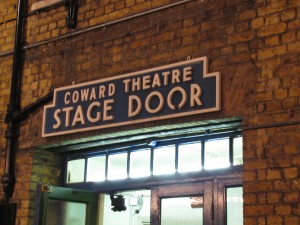
After Deathtrap
In my last theatre blog, I talked about stage door and how I was slightly disappointed about the response from the actors. (Summary: it isn’t as popular as it is in the US, probably because of the whole extreme privacy issue.) Since then, I’ve had a bit more success at the Stage Door, including meeting the majority of the leads of Wicked, Jonathan Groff after Deathtrap, and a couple of the Les Mis 25th Anniversary cast, including Marius and Valjean. I’ve decided that the privacy issue is most definitely part of it and there are two types of actors: the one who signs and mumbles a “thanks” and the one who talks to you about the performance. (While this is true in the US as well, 99% of those I’ve met fall into the later category, where it is the opposite here.) At Wicked, two actresses (the witches) commented that there were actually fewer people at the door than usual, which leads me to believe that is more than just a privacy issue. I noticed a major difference in the type of the show where people did stage door and where the actors were involved in it rather than walking away at a brisk pace: the stereotypical West End show (Wicked, Les Mis) where the actors expect it because of a huge fan base and the more intimate, less glitzy shows (Deathtrap).
The other thing that has struck me about theatre here is how self-aware the shows are. Most of them have made fun of some part of British culture, including apologizing until it was past ridiculous. In The Habit of Art, the show confronted theatrical issues, which led to several people commenting on how it was likely the most elitist piece we had seen. But Deathtrap did the same thing in a very non-elitist way. Still a play-within-a-play, the play didn’t interrupt the other play (I can’t really say more without giving away the plot) and the commentary on the superiority of writers over their actors was still present without being theatre-specific. Instead of inside jokes, the literary jokes were more common place: Arthur Miller and sales cases vs. the National Theatre’s specific theatres. In most of the shows I’ve seen in the US, I feel that the show didn’t make fun of theatre the way it does here. I think this isn’t because the English are more aware, but are less likely to be openly critical of anything and more likely to deal with it with humor and irony.
I’ve enjoyed my theatre experiences and I hope when I visit London I’ll be able to see other shows. (Or Deathtrap again.)
Tags: 2010 Stephenie · Theatre
September 21st, 2010 · 1 Comment
While I did take an American theatre class this summer, it was at Villanova, which let’s face it, is no Dickinson. And anyway, I’m not qualified to the point where I could say anything valuable about the theatrical worth about the three plays we saw as a group, so I’ll try to stick to more tangential attributes of the three outings. (For the record, my rankings, from most to least favorite: 1. “The Habit of Art” 2. “The Merry Wives of Windsor” 3. “39 Steps”)
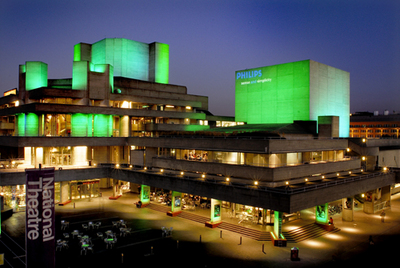
via Google Images
I did not find the backstage tour of the National Theatre particularly fascinating. It just struck me as a lot of inside baseball about producing plays; perhaps if I knew more about the nitty-gritty of theatre, I would have enjoyed it more. But as we walked through the facility, something slowly began to hit me: there is nothing remotely comparable to this venue back in the States. On top of it being spectacularly massive, the NT also receives substantial subsidies from the national government. I’m not sure if I’m willing to make the blanket statement that Britain is more willing to spend taxpayer dollars on fine arts, as the NEA at home is a great, strongly funded institution. There can be no question however, that when it comes to the particular art of theatre, Britain has a certain national pride in the craft that leads to much stronger support for it.

We’ve heard from both Rick Fisher and John The Tour Guide that the Globe is a silly endeavor, with Mr. Fisher going as far to call it “fake Shakespeare.” That said, it was undeniably cool to lean on the stage and pretend to myself for a minute that Shakespeare’s company performed in a similar setting in the same place. And there was an element of the Elizabethan audience (infamous for its rowdiness) as the Nalgene bottle full of wine belonging to the gentleman standing next to us slowly was emptied as Falstaff’s nefarious plot was uncovered. By the time “So Merrily” was performed at the end, our neighbor was literally punching the stage as he thought he was tapping in time with the song. So while I didn’t enjoy the play as much as that guy, I had a good time at the Globe.

via Google Images
39 Steps was my least favorite of the three plays, but I still enjoyed it. The number one takeaway for me was that British humor is simply different. I found the play funny on the whole; that said, there were multiple moments where I did not laugh at all and the Brits in the audience were rolling on the floor.
Tags: 2010 Dennis · Theatre
September 21st, 2010 · No Comments
Of all of the theater events we attended, 39 Steps was my favorite. The slapstick nature of it kept me engaged, even though I had no idea what was going on during most parts of the play. Also, the actors were able to change character quite easily, and they had to with only four actors on stage. Of course, these characters were completely static, and this play was certainly not the most thought provoking. Being on Piccadilly Circus, the Criterion Theatre was clearly one of the more touristy of the theatres in London, so obviously they were not trying to cater to an erudite British crowd.
The Habit of Art was far to confusing for me, I never really understood the purpose of the group of characters sitting off to the right side of the stage. Most of these characters had extremely minor roles, which was unnecessary to the progression of the plot in my opinion. It was also difficult to tell if the dialogue on center stage was the discussion of the production, or a “play within a play”. It probably didn’t help that I was near-comatose at the time, and this overt intellectualism was not welcome at the time. I think I would have been able to appreciate this play more if it was a matinee and I had been more awake at the time.
The Merry Wives of Windsor was the most difficult for me to sit through. I was pretty jetlagged at the time, and it didn’t help that my grasp of Elizabethan English was already tenuous. Also, standing in a crowd for two and a half hours after having walked over London, mye legs were killing me at that point. However, I though that the recurring innuendo on latin lessons was funny, especially considering my experience in high school latin was very masochistic as well.
Tags: 2010 Tyler · Theatre · Uncategorized
September 21st, 2010 · No Comments
I saw five plays in my time here in London, and found the theatre to be one of my favorite aspects of the city. My favorite was Les Miserables, although I sat in the absolute back row and was very far from the stage. The music was tremendous and the acting spectacular. I especially enjoyed the spinning stage, which, although I recall hearing in our theatre tour that it is not altogether uncommon, I had never seen before. 39 steps, while not high theatre, was a lot of fun. The Hitchcock feel of the whole play was really enjoyable and the physical comedy was great. The use of only four actors had me feel like I got to know the actors, not only the characters. This was especially true for the two male actors beside the main character, they were extremely likeable and the four actor format helped foment that. Bedlam was a disastrous play but still a decent experience. From Bedlam I learned that the a bad play is a whole lot more fun than a bad movie, and started me to thinking that plays are a way I would like to spend my evenings. This is despite a complete lack of direction or solid musical numbers and a cast that became almost disinterested by the end of the performance. I also noticed that due to the Globe’s choice of lighting, in which the entire stage is rather evenly lit, the play was at times hard to follow, because it was impossible to know where exactly to look. Merry Wives of Windsor was funny, although I got quite lost at the end of the play unfortunately. After a long day of walking, standing at the theatre was particularly hard for me that day. The Habit of Art was an overall failure in my opinion. It took some excellent themes and fears and excellent acting and buried it in a clumsy and unnecessary frame. We had some genuinely moving scenes between Britain and Alden which could have been drawn out and extrapolated on, but instead we had a lot of little side jokes mainly based on the ‘play in a play’ format.
Overall, the theatre in London has changed my perspective, I’ve realized that a night out with a show is extremely enjoyable. If I had vacation time here I think I would see three to five shows a week. If I lived and worked here I would do the same. It’s very exciting, the theatre scene here and the fact that any night on a limited budget I can go see so many shows, both classics and experimental, new shows.
Tags: 2010 Michael · Theatre
September 20th, 2010 · 1 Comment
I’ve thought about it, and out of the three plays we’ve seen (or at least the ones we were required to have seen), Habit of the Art, is my favorite. Considering I fell asleep for twenty minutes during the play, I take it to be somewhat of an odd choice. But while the impression I had received afterwards from the other two plays (Merry Wives & 39 Steps) dissipated within hours of viewing, Habit, oddly enough, stuck with me for much longer. No, Habit does not have the seamless grace of dialogue and movement of the Shakespearian comedy, nor the zest and technical splendor of the Hitchcock inspiration. What it does have, however, is a surprisingly powerful – if at a times tedious – meditation on the persistence of making art, making it despite the absence of a theatrical director or the lost prospect of an unremitting future.
I’ve seen very few plays in my life so I’m not able to judge the Alan Bennett piece from a holistic and comparative knowledge of the theatre, but I do know that I liked it, and that it offered something that the other two plays didn’t: the opportunity for thought, that is, a chance to immerse myself into the intricacies of the work, long after its performance. *Deep breath* Merry Wives, forgive me, is WEAK Shakespeare. You won’t find a critic who will champion it before Much Ado About Nothing or Twelfth Night. It does its job though, and that is to give us a good laugh. 39 Steps, while somewhat entertaining, is much too vaudeville, too slapstick for me to take seriously (it was more of a treat listening to Mikey and Carol-Ann trade laughs). As a parody on the film of the same name, however, the play does its job in replacing suspense with comedy. But I do not like Habit because it is the seemingly least funniest of the two. (For the record, I think Wood Allen’s prose should have won him a Pulitzer). I like it because the play’s reflections on art and mortality, and ambition and creativity is invariably more interesting than seeing Falstaff duped by faeries (okay, I won’t go that far, but you take the point). Its a play that makes you think about yourself and the act of creation, whether it be some poetry you write on a napkin in a cafe or the 18 inch mural you have to complete by Friday. Someone wrote that the play was too “high-minded.” I fail to see how. What is so pretentious about a group of actors trying to get through a day’s rehearsal?
Habit, did not blow my mind by any measure. I disliked it upon viewing. But as I’ve been explaining, the play lingered with me, and eventually I came around. Much of the humor I did not understand, but that was most likely because of a cultural rift than anything else (as laughter from the native British folk was prevalent during the duration of the play). Yet the innovative, self-reflexive narrative intrigued me, and did much to compensate for the static mise en scene. I see myself watching it again – later, when I’ve the chance to read more Auden.
All in all, I’ve enjoyed the theatre I’ve experienced in London so far. In Korea, theatre culture is largely concentrated in one district of Seoul, a spot that specializes in more contemporary and avant-garde productions. Although you can catch traditional folk plays in the more rustic cities, as far as modern plays go, the options aren’t so many. What compounds the problem of availability is attendance – a relatively low number of people frequent the theatre (Koreans see more movies, and although that may be the case for just about any other country, Korea has the distinction of being one of the few countries that makes more money off of its domestic films than foreign ones, a fact that is even more compelling when you consider that the screen quota is much skewed in favor of imported films). Just the sheer number of programs that are billed here in London is a reminder that there is a population that demands them. I’ve noticed that many people in the gray and distinguished demographic visit the theatre, at least judging from the three that I’ve gone. Considering that Habit deals with homosexuality so frankly, it is somewhat of a surprise to me that many elderly were in attendance. Maybe the seniors in this country are less conservative, less puritanical than in America? I’ve also seen plenty of children and teenagers at these events as well. Not to mention the vast number of students our age and men and women in their thirties and forties. The diverse population of theatre-goers is a testament to the strong cultural tradition in this city. Perhaps its time for other cities to follow suit.
Tags: 2010 Sean · Theatre
September 20th, 2010 · 1 Comment
I have attended four shows in my time in London: The Merry Wives of Windsor, 39 Steps, the Habit of Art, and Les Miserables. I have searched and searched to find a common thread that all four would have to define the theatre in England and have yet to come across it. There are some thematic similarities (thank you very much Jesse for pointing out the cross dressing), but overarching commonalities that I could use to define London theatre are difficult to find.
The first play that we saw in London, The Merry Wives of Windsor, was understandably a tourist trap. It was at the New Globe (a touristy place if I’ve ever seen one) and therefore, I had pretty low expectations. I expected a good piece of slapstick Shakespeare and that is exactly what I got. I got a “genuine” Shakespeare experience – I stood right by the stage, listened to flippant German teenage tourists mock the English actors, and got in a good laugh. While there was some genuine real life Brits in line in front of us (I got to witness a queue-jumping situation that would have made Kate Fox dance with joy), I felt like I was not at a real English theatre event.
39 Steps was, for me at least, the most real English theatre I witnessed. As it was a matinee, there were distinct groups of English people, namely a group from a convalescent home and a very large group of school children. The audience was very much stiffly British and listening to the aid in front of me explain the humor to the most ancient woman I’ve ever seen made me feel the most immersed in British life I had been to that point. The most telling sign that I was truly experiencing British theatre was the rampant irony used in 39 Steps – most of which, I would like to point out, completely went over my head (I only knew that something funny was going on by the chuckles of my fellow theatre goers).
The Habit of Art might not have made that much of impression on me simply because I did not enjoy it. Like most theatre I’ve participated in back home, it struck me as an upper class audience out to enjoy a night of snobbishly intellectual theatre that they could go to a cocktail party and brag about. I know that during our tour our guide pointed out how they try to make the theatre financially accessible to everyone, but it was not something that I felt the ordinary Joe could go into an enjoy. The topic required some degree of literary knowledge, the humor was highbrow, and the audience was mainly fashionable and wealthy people who I would guess visit the theatre frequently. Overall, I felt no real connection to either the play or my fellow audience members.
Les Miserables was perhaps my favorite piece of theatre. While, like The Merry Wives of Windsor, it was definitely geared towards tourists, I finally felt like I was somewhere where half the humor (and there was not much humor to choose from) was not going over my head. I could sit back, relax, pay attention to the lighting (thanks Rick!), and enjoy a night of good music. I loved that Les Miserables was not attempting to be anything more than it was and because of that, I was able to loosen up and enjoy the show.
The four shows that I saw in London were all enjoyable and filled their own niche in the theatre community. Together they said nothing grand or profound about British theatre but individually had a lot to offer in terms of cultural explanation.
Tags: 2010 Amy · Theatre
September 19th, 2010 · No Comments
I’m a huge theatre fan (always have been, always will be), so pretty much every moment of spare time I’ve had here that hasn’t been taken up by projects or illness has been spent at the theatre. Many people have already written about individual shows, so I’m going to try and give a comprehensive look at what I’ve seen here in London and where:
–The Merry Wives of Windsor, The Globe Theatre (Southwark/Bankside)
-The 39 Steps, The Criterion Theatre (Piccadilly Circus)
–Bedlam, The Globe Theatre (Southwark/Bankside)
–Aspects of Love, The Menier Chocolate Factory (Southwark)
– Les Miserables (the 25th Anniversary production), The Barbican Centre (Southwark)- TWICE
–Henry IV: Parts One and Two, The Globe Theatre (Southwark/Bankside)
–Passion, The Donmar Warehouse (Covent Garden)
–Wicked, The Apollo Victoria (Westminster)
I’m only going to mention my experiences at the Globe briefly, as I’ve been going to bat constantly in defense of Bedlam and it’s sort of exhausting! I found Merry Wives to be entertaining – it’s not one of my favourite Shakespeare plays, but the cast was fantastic. I saw Bedlam on opening night – its world premiere performance – and I was blown away by it. I wanted to go back and see it again but that didn’t end up working out, though I did pick up a souvenir program and a script on my Henry IV Marathon Day.
Ah, and speaking of Henry! . . . As part of the educational Shakespeare company I interned with for two years, I assistant directed Part One of Henry IV twice, so I was very familiar with the show. I decided to go on a day where I could see both Part One and Part Two which equalled about 8 hours spent in or near the Globe- HEAVEN! I thought the cast of both Parts gave extremely strong performances, particularly Roger Allam as Falstaff and Jamie Parker as Prince Hal. It was also entertaining to see cast members from Bedlam playing different roles, sometimes bit parts really, which made me pay much more attention to them. It was so interesting to see Sam Crane (the foppish Laurence in Bedlam) as Hotspur in Henry or Phil Cheadle, who stole my heart as Doctor Maynard in Bedlam, playing a trio of small roles (Douglas/Davy/Lord Bardolph), or Jason Baughan, the mad doctor in Bedlam, as Westmoreland/Peto, or even seeing Barbara Marten, the neglected wife in Bedlam, as the hillarious Mistress Quickly in Henry. My only complaint about the Henry plays is that I would have liked to see them before Merry Wives, as Merry Wives is the sequel to both Henry IVs and Henry V. Still, knowing the characters and what becomes of Falstaff in Merry Wives made the Henrys all the more enjoyable!
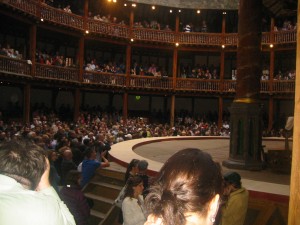 My view of Bedlam (taken during the interval, of course!)
My view of Bedlam (taken during the interval, of course!)
And me at the site of the original Globe.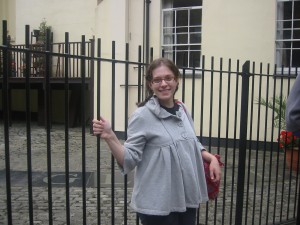
I was pleasantly surprised by The 39 Steps. I didn’t know anything about the play or the cast but, being a film fan, knew that the title at least came from a Hitchcock-type, film noir-ey movie. Imagine my surprise when I discovered it was more spoof than thriller! The Criterion itself was BEAUTIFUL, a gorgeous venue and perfect for such an affectionately-nostalgic play. The UK tour will be hitting Norwich in April, so I’m going to try and go to see if I like it as much with a different cast.
Now. Les Miserables. Bear in mind that I’ve seen Les Miz more times than I would like to admit, have more cast recordings than I’d like to count and in more languages than I should probably tell. This musical was a huge part of my life for about 3 years in high school and had a huge shaping effect on my musical tastes. I didn’t want to see the production at the Queen’s Theatre because it was a bit of “been there, done that”- let me explain to the uninitiated: pretty much all of the musicals Cameron Mackintosh produces (Phantom of the Opera, Cats, Les Miz, Miss Saigon, etc) are brilliant shows but get boxed up and set to be mass produced globally. That basically means, the blocking, lighting, staging, set, costumes, all the onstage “business” will be the same from production to production. That cross Valjean makes downstage left in the middle of Act 2 will be made by every Valjean from Alaska to Hong Kong. That was why, when I heard there was a special, newly restaged version being presented at the Barbican (the original home of Les Miz’s first production) in honour of its 25th Anniversary, I jumped at the chance to go.
To try and express how incredible this production was is beyond me at this point, particularly as I’m tired, sick and sniffly. Suffice it to say, it was MAGICAL. The creative team took a show that I know inside and out, blast its stitches apart and made it something fresh and new, while keeping the same heart, the very core of the show which I fell in love with in the first place. They did away with the annoying rotating stage and used a much more intimate, less intimidating set. New costumes. New orchestrations. New musical cuts. New lighting. I had goosebumps from the sheer awesomeness of it.
Which is why, after getting out of the show Wednesday night (the 15th), I immediately called my partner in crime and fellow Les Miz fanatic, Stephenie, and told her she NEEDED to get tickets. Before I quite knew where I was, we had tickets for the very next night’s performance and were seeing the show together. Seeing the show by myself had been amazing enough but having someone with me who could understand my strange musical-fan language and decipher from just an elbow in the ribs my excitement at the inclusion of a moment from the original novel into the stage production was beyond awesome!
 [At the Barbican. Photo grudgingly taken by Stephenie :D]
[At the Barbican. Photo grudgingly taken by Stephenie :D]
Oh, and we stood at the stage door to get our programs signed. Everyone but the two of us left after Gareth Gates (who played Marius and was, apparently, on the British version of American Idol, or something) had gone, so we were the only ones waiting for Valjean and the other leads- which is VERY STRANGE in the world of Stage Door. We had to call after John Owen Jones (who played Valjean, and is, in my mind, a demi-god) to get him to stop. So, we awkwardly stood at the stage door until 11:30pm (which, no doubt, led to my getting sick) until we decided to head back to the Arran House. We got on the tube at Barbican and decide to transfer to Moorgate so we can take the Northern line to Goodge. Still with me? So we’re walking through the station to get to the right platform and who should pass us? John Owen Jones (Valjean). Yep. And we were the only two at stage door, plus I was wearing my Les Miz shirt and Steph had her program out so we looked like complete stalkers. Did I mention he had left 20 minutes before we did? So how did he end up getting off at Moorgate at the same time? It astounds me . . . . And guess where he was headed? Yes, the Northern Line! He got into the same CAR as we did and Steph and I tried to remain calm and casually take some stealthy stalker photos of him (fail) but he got off at King’s Cross before we could succeed.
Going back a bit further, there is one theatrical experience which I must list as my favourite: Aspects of Love, at the Menier Chocolate Factory. This is one of Andrew Lloyd Webber’s least-well known shows (it is my personal favourite, even above Phantom of the Opera) and it was a miserable failure on Broadway and only played 3 years in London. I knew about the upcoming production before I had even left the States and I was thrilled, as this is the first major production in London since the original. This show is LITERALLY never put on, especially not in the United States (I saw a truly abysmal concert version in Los Angeles my senior year of high school which I’ve tried to erase from my memory). My pet theory on this is that it’s just not a flashy, pretty spectacle-type musical: it’s a deeply moving exploration about the agony of love as told through an incredibly complex story and fantastically beautiful music. To find out more about the show, take a look at: http://en.wikipedia.org/wiki/Aspects_of_love. The Menier is my favourite theatre I’ve visited so far- it is a huge success story, as it operates entirely without any government support and, thereby, is able to produce some truly incredible theatre. It has all the closeness and intimacy of a local community theatre with the talent of a full-scale West End production. Do check out their website: http://www.menierchocolatefactory.com/pages/about_us
The show itself was fantastic- I couldn’t have asked for a better production. To make things even better, I proved that Kate Fox is wrong about the English’s coldness and made friends with the girl working in the box office (whose name- Amanda- it only took me till the interval to find out!) as we mutually geeked out about how much we love the musical. I arrived home on a cloud of musical-induced bliss!
And, most recently, last night I saw Stephen Sondheim’s musical Passion at the Donmar Warehouse (http://www.donmarwarehouse.com/pl111.html) with Stephenie. As with Aspects of Love, this is a show whose music I know extremely well but which is not successful or oft performed because of its intensely emotional, cerebral nature. The Donmar is an incredible theatre – like the Menier, known for its intimate space- and it was the perfect setting for such an emotional complex and poignant piece of music as Passion.
 [Passion logo from: http://3.bp.blogspot.com/_1DZU-LyGw2Q/TFJkwODs5JI/AAAAAAAABLg/F-ss3TaKSSU/s1600/passion.jpg]
[Passion logo from: http://3.bp.blogspot.com/_1DZU-LyGw2Q/TFJkwODs5JI/AAAAAAAABLg/F-ss3TaKSSU/s1600/passion.jpg]
As for the last one on my list, Wicked, it’s a show I’ve seen often in Los Angeles. Stephenie and I (along with some others, I believe) are going Tuesday night before we head out of London. It’s by far the most commercial/touristy of the musicals I will have seen here, but I am looking forward to it nonetheless and am interested in seeing some changes that I believe were made to the show when it came here to London.
If I take away nothing else from this time in London, I’ll have gotten to see some damn good theatre!
Who could ask for anything more?
Tags: 2010 Elizabeth · Theatre
September 18th, 2010 · 1 Comment

All My Sons Poster for the Apollo Theatre
On Thursday evening I went to see Arthur Miller’s play All My Sons at the Apollo Theatre. Not to boast too much—I’m sure most people are tired of hearing about it—but three others and I purchased box seats in the theatre for only £10 each. We had to wake up early to queue for two hours in the bitter cold before the box office opened at 10am. It was definitely well worth feeling frozen for the rest of the day in order to see the play that evening.
I’m familiar with two of Arthur Miller’s other plays, Death of a Salesman and The Crucible, but knew nothing whatsoever about All My Sons. The play itself was very enjoyable—natural, uncomplicated lines presented by seemingly simple characters. Without examining the acting itself, the play’s deeper meanings and the presentation and development of them was brilliant. However, I’m no qualified theatre critic, so I’ll stick to sharing my reaction to the adaptation I saw.
The Apollo Theatre itself is a “Grade II listed West End Theatre, on Shaftesbury Avenue in the City of Westminster” and was built in 1901 (cited in above link). It’s a traditional theatre in that it has a large main stage with a cozy gallery of seats located on its ground floor, two upper balconies and side box seats. The audience for Thursday’s performance was mature. I would say most of the viewers were in their sixties. Us four Dickinsonians were definitely the youngest box seat ticket holders. The playwright Arthur Miller was, after all, very popular throughout the 1940s, ‘50s, and early ‘60s, so the maturity of the audience made sense.
In regards to where I sat in the theatre, the box felt like it was almost hovering over the stage. My view was somewhat restricted, but never before did I have the opportunity to see the actors’ facial expressions and gesticulations in such detail! Moreover, the setting—which included a real grass floor, an abundance of vegetation, and the front of a country house—could also be seen in great detail. Altogether, I was able to watch an incredible play and truly be a part of the scene.
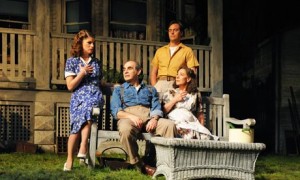
Main cast members of Arthur Miller’s Play
In All My Sons I was blown away by the two main actors’ performances. David Suchet’s reenactment of Joe and Zoë Wanamaker’s interpretation of Kate were absolutely extraordinary. For one, Suchet portrayed Joe’s sudden emotional changes flawlessly and with ease. One moment he could be furious, the mood convincingly illustrated in every corporeal and facial expression, and suddenly he would become vulnerable and distraught with tears streaming down his face. To me, the only negative aspects of the show were: the supporting cast’s American accents slipping at times (something I actually found amusing) and the set’s peculiar depiction of the Ohio countryside as looking more like the Louisiana bayou.
In the end though, All My Sons far exceeded the other theatre productions I’ve seen in London. Shakespeare’s Merry Wives of Windsor is still a favourite, especially since it was my first experience in the Globe Theatre. Bedlam, also in the Globe, was enjoyable only because of the jokes I shared with fellow classmates afterwards. I did love Les Misérables with its brilliant lighting, impressive set design, and Éponine’s angelic voice, but I wasn’t blown away by the performance (it did not help that my seat was in the uppermost balcony). 39 Steps was innovative and entertaining, but I found the slapstick humour dull after a while. The Habit of Art forced me to consider deeper, more intellectual ideas but was not the most well written play, I think. All in all, I have thoroughly enjoyed my theatre experience in London—although I would love to see some dance while I’m still here in England—and have appreciated every play and musical I have seen thus far.
If you haven’t see All My Sons yet, please do, and share your thoughts!
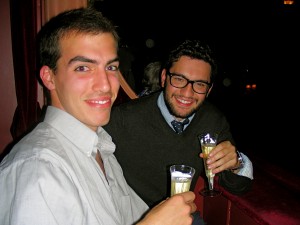
Patrick and Matt at the play All My Sons (personal photo)
Tags: 2010 Mary · Theatre
September 18th, 2010 · 1 Comment
Theatre in England is a casual affair. In the United States, a night at the theatre is a formal event full of dressing up and champagne, a night a kin to going to a highbrow gala if you will. To some extent in England theatre is a reason to look nice, but it is not the event it is the United States. This is apparent by the five plays I have had the pleasure of seeing in the short time I have been in London.
“How plays in a month?” You may be asking, “How can he/the program possibly afford such a feat.” There in lies the casual atmosphere of the theatre. Tickets can be acquired relatively cheaply, I myself was able to procure box seats for Arthur Miller’s All My Sons a few nights ago for only 10 pounds and a few less hours of sleep.
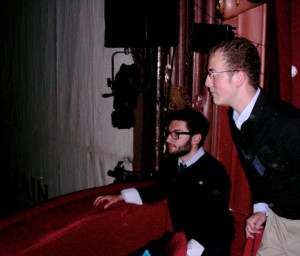
Perhaps it is because being on Broadway just costs more for the production and therefore for the viewers, but the lower costs of London’s theatre scene allows both the viewers and the audiences to try something new. People, even on our program, are much more inclined to go see something they wouldn’t normally because it is only 10 pounds and not an outstanding 50-dollar balcony ticket like in the United States.
The lower costs also allow for more experimental theatre. Plays have the privilege to try things that the audience may not like because there is not as much of a monetary responsibility to the theatre. In the United States, a show will not be put on Broadway unless someone decides it can make money, and if it can make money it will go on an absurd 10 year run. With all of the heavy hitting Broadway shows that have been around for decades taking up the theatres, it leaves very little open space for the new, risky, and innovative.
I’m not saying entirely that theatre on Broadway has become stagnant and purely a moneymaking business, but I am saying that mostly. Off-Broadway is still a place in New York where one can see a risky new show, like this summers hit Bloody Bloody Andrew Jackson which I had the great honor of seeing in early July. To me though, it’s not about the surprising hit that emerges from the risky new theatre, its about the bombs. What shows you about London’s theatre scene are the flops, the things you see in Timeout magainze with only one star and a skull and cross bones warning you not to see the show.
Seeing Bedlam at the Globe theatre was not one of my fondest memories of London but the fact that a show of that caliber, written by novice playwright, could make it to one of London’s most iconic theatres without fear of a monetary disaster is inspiring and gives me hope for theatre to come.
Tags: 2010 MatthewG · Theatre











